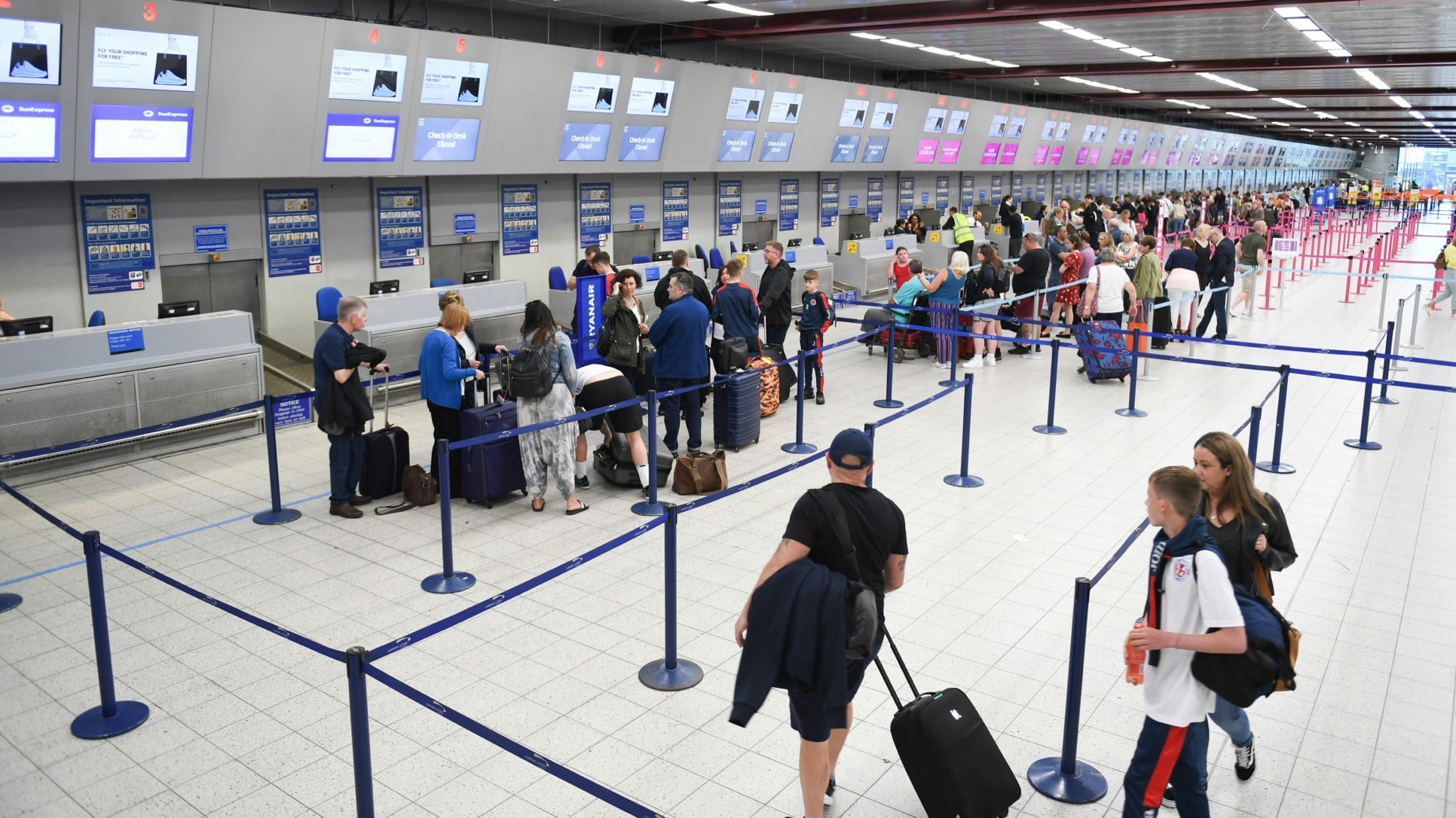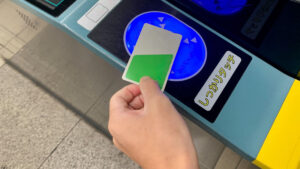Traveling to Japan is exciting, but navigating airports, immigration, and customs can be a little intimidating—especially if you don’t speak Japanese. This practical guide introduces essential Japanese phrases to help you move smoothly from arrival to your final destination. Whether you’re filling out forms, talking to staff, or facing unexpected situations, you’ll find the phrases you need to feel confident and prepared.
Contents
Understand the Process from Arrival to Immigration
When You Arrive at the Airport
Once you arrive at a Japanese airport, the first thing to do is look for signs that say
「入国 (Immigration)」 or 「乗り継ぎ (Transfer)」.
Most Japanese airports offer multilingual signage including English, Chinese, and Korean,
so it’s generally easy to navigate. However, understanding a little Japanese can give you extra peace of mind.
How to Read Signboards and Useful Vocabulary
Japanese airports have many signboards to help travelers find their way. Memorizing the following terms can help you move smoothly:
| 日本語 | Romaji | English |
|---|---|---|
| 入国 | Nyūkoku | Immigration |
| 出国 | Shukkoku | Departure |
| 手荷物受取 | Tenimotsu uketori | Baggage Claim |
| 税関 | Zeikan | Customs |
| 乗り継ぎ | Noritsugi | Transfer |
| 案内所 | Annaijo | Information Desk |
It’s a good idea to save these words on your phone or keep them in a note for quick access when needed.
How to Distinguish “Immigration” and “Transfer”
The direction you need to take depends on the purpose of your travel:
- Entering Japan (for tourism, business, etc.): Follow signs for 「入国」or “Immigration”.
- Connecting to another international flight: Look for 「乗り継ぎ」or “Transfer”.
Useful Japanese phrases if you’re unsure:
- 「入国はどちらですか?」
Nyūkoku wa dochira desu ka?
(Where is immigration?) - 「乗り継ぎはどこですか?」
Noritsugi wa doko desu ka?
(Where is the transfer area?)
Helpful Phrases When You Need Assistance
If you feel lost or unsure, don’t hesitate to ask airport staff or visit an information desk. These Japanese phrases can help:
- 「すみません、○○はどこですか?」
Sumimasen, ○○ wa doko desu ka?
(Excuse me, where is ○○?) - 「英語を話せますか?」
Eigo o hanasemasu ka?
(Can you speak English?) - 「入国審査に行きたいです」
Nyūkoku shinsa ni ikitai desu
(I want to go to immigration control)
Most airport staff in Japan can communicate in English, so stay calm and speak politely — you’ll likely receive the support you need.
How to Fill Out the Immigration Card and Customs Declaration Form
When you enter Japan, you will be required to fill out two forms:
1. An Immigration Card (Disembarkation Card for Foreigners)
2. A Customs Declaration Form
Both are usually available in English, but some fields may require simple Japanese. Here’s how to fill in the key sections.
How to Write Your “Purpose of Stay”(滞在目的)
You’ll be asked to write your purpose of stay in Japan (滞在目的 / taizai mokuteki). This field helps immigration officers understand why you’re visiting. Choose one of the following depending on your situation:
- 観光(Tourism)– for sightseeing or vacation
- ビジネス(Business)– for work meetings or events
- 友人訪問(Visiting Friends)– if you’re staying with someone
- 親族訪問(Visiting Family)– if you’re visiting relatives
- その他(Other)– for anything else; you can explain in English
You can write these directly in Japanese or use English, as most immigration officers can understand both.
Tips for Writing Your Occupation and Place of Stay
You may also be asked to write your occupation (職業 / shokugyō) and place of stay (滞在先 / taizai saki).
Occupation examples:
- 会社員(Office Worker)
- 学生(Student)
- 無職(Unemployed)
- フリーランス(Freelancer)
- 自営業(Self-employed)
Place of stay: Write the name and address of your hotel, Airbnb, or host. Example:
“Shinjuku Granbell Hotel, 2-14-5 Kabukicho, Shinjuku-ku, Tokyo”
Tip: Keep a printed or digital copy of your accommodation info—it may be requested at immigration.
How to Fill in the Signature and Date Fields
Most forms will ask for your signature (署名 / shomei) and the date (日付 / hizuke).
- 署名 (Signature): Sign your name as it appears in your passport.
- 日付 (Date): Use the format
YYYY/MM/DD(e.g.,2025/07/08).
Avoid writing the date in the MM/DD/YYYY format, as it may cause confusion. Japan uses the year/month/day style.
Once the forms are filled out, keep them ready for immigration and customs officers to check after your flight.
Interacting with Immigration Officers
At the immigration checkpoint, you will need to show your passport and completed forms, and answer a few simple questions. Don’t worry—officers are used to assisting foreign travelers, and being prepared will help you feel more confident.
Common Questions and How to Answer Them
Here are some typical questions immigration officers may ask in Japanese, along with how to understand and answer them:
| 質問(Japanese) | 意味(English) | 答え方の例(Example Answer) |
|---|---|---|
| 滞在目的は何ですか? Taizai mokuteki wa nan desu ka? |
What is the purpose of your visit? | 観光です。 Kankō desu. (Tourism) |
| どこに泊まりますか? Doko ni tomarimasu ka? |
Where will you stay? | 〇〇ホテルです。 〇〇 Hotel desu. |
| 何日間滞在しますか? Nannichikan taizai shimasu ka? |
How many days will you stay? | 5日間です。 Itsuka-kan desu. (Five days) |
You can also respond in English if needed—most officers will understand or call someone who does.
How to Say “I Don’t Speak Japanese”
If you’re struggling to understand the officer, it’s okay to let them know clearly and politely:
- 「日本語が話せません」
Nihongo ga hanasemasen
(I can’t speak Japanese) - 「英語でお願いします」
Eigo de onegaishimasu
(English, please)
Saying this at the start can help the officer adjust their communication or call someone who speaks English.
Helpful Phrases When You Feel Nervous
Immigration can feel intimidating, especially if it’s your first time. Here are some phrases to help you ask for support calmly:
- 「ゆっくり話してください」
Yukkuri hanashite kudasai
(Please speak slowly) - 「もう一度お願いします」
Mō ichido onegaishimasu
(Please say it again) - 「わかりません」
Wakarimasen
(I don’t understand)
Using even just one of these phrases politely can go a long way.
Useful Japanese at Customs and Baggage Claim
Finding Your Luggage at the Baggage Carousel
After passing through immigration, head to the baggage claim area and look for your flight number on the screen above the carousel (ターンテーブル). If your bag doesn’t appear or you’re unsure which one is yours, don’t panic—here are some useful phrases and tips.
How to Say “I Can’t Find My Luggage”
If your suitcase doesn’t show up, speak to the nearby staff politely. Use the following phrase:
- 「荷物が見つかりません」
Nimotsu ga mitsukarimasen
(I can’t find my luggage)
You can also describe your suitcase in simple terms:
- 「黒いスーツケースです」
Kuroi sūtsukēsu desu
(It’s a black suitcase) - 「ステッカーがついています」
Sutekkā ga tsuiteimasu
(It has a sticker on it)
Tip: Keep your baggage tag (usually stuck to your passport or boarding pass). It helps staff locate your luggage faster.
Simple Phrases to Ask Staff for Help
If you’re unsure or confused, you can ask a nearby airport staff member:
- 「すみません、荷物が出てきません」
Sumimasen, nimotsu ga dete kimasen
(Excuse me, my luggage hasn’t come out) - 「係の人はいますか?」
Kakari no hito wa imasu ka?
(Is there a staff member?) - 「英語が話せる人はいますか?」
Eigo ga hanaseru hito wa imasu ka?
(Is there someone who speaks English?)
Even if the staff doesn’t speak fluent English, showing them your baggage tag and calmly pointing to the carousel is often enough to get help.
Be Careful with Look-Alike Suitcases
Many bags may look similar. Before taking one from the carousel, check the following:
- Check the name tag or baggage label
- Look for any personal identifier (ribbon, sticker, etc.)
If someone mistakenly takes your bag or you see a similar one:
- 「これは私のではありません」
Kore wa watashi no dewa arimasen
(This is not mine) - 「この荷物を間違えました」
Kono nimotsu o machigaemashita
(I took the wrong luggage)
Being polite and calm is key—airport staff will assist you right away.
Conversations at the Customs Checkpoint
After you collect your luggage, you must pass through customs (税関 / zeikan). You will hand in your Customs Declaration Form and may be asked a few questions. Here’s how to respond clearly and respectfully.
How to Respond to “Do You Have Anything to Declare?”(「何か申告するものはありますか?」)
This is a common question at customs. In Japanese, it is usually asked as:
- 「何か申告するものはありますか?」
Nanika shinkoku suru mono wa arimasu ka?
(Do you have anything to declare?)
If you have nothing to declare, simply say:
- 「いいえ、ありません」
Iie, arimasen
(No, I don’t)
If you do have something to declare (e.g., large cash, valuable goods, restricted items), show it and explain in English or with the help of your form. It’s okay to say:
- 「少しあります」
Sukoshi arimasu
(Yes, a little)
How to Say “These Are Gifts” or “For Personal Use”
If you’re bringing items for friends or family, or personal belongings, customs officers may ask:
- 「これは何ですか?」
Kore wa nan desu ka?
(What is this?)
Here are useful phrases to respond:
- 「お土産です」
Omiyage desu
(These are souvenirs) - 「個人使用です」
Kojin shiyō desu
(For personal use) - 「プレゼントです」
Purezento desu
(They are gifts)
If they ask about the quantity or value, just answer honestly. Keep receipts if possible.
Useful Japanese if English Doesn’t Work
Most customs officers understand basic English, but if you’re having trouble communicating, these Japanese phrases can help:
- 「日本語が話せません」
Nihongo ga hanasemasen
(I can’t speak Japanese) - 「英語を話せる方はいますか?」
Eigo o hanaseru kata wa imasu ka?
(Is there someone who speaks English?) - 「書類を見てください」
Shorui o mite kudasai
(Please look at the document)
You can also point to your declaration form and use gestures if needed.
When You’re Asked to Open Your Bag for Inspection
Sometimes customs officers may ask to inspect your luggage. This is a routine process and nothing to worry about. Below are common Japanese phrases and useful tips to help you stay calm and cooperative.
How to Say “May I Open Your Bag?”(「カバンを開けてもいいですか?」)
If a customs officer wants to check your luggage, they may say:
- 「カバンを開けてもいいですか?」
Kaban o akete mo ii desu ka?
(May I open your bag?)
You can respond politely with:
- 「どうぞ」
Dōzo
(Go ahead / Please do) - 「はい、開けます」
Hai, akemasu
(Yes, I’ll open it)
Tip: Try to keep frequently inspected items (electronics, souvenirs, snacks) near the top of your bag for easy access.
How to Answer “What Is This?”(「これは何ですか?」)
During inspection, you may be asked about specific items. The officer might say:
- 「これは何ですか?」
Kore wa nan desu ka?
(What is this?)
Here are example responses:
- 「お菓子です」
Okashi desu
(It’s snacks / sweets) - 「服です」
Fuku desu
(It’s clothing) - 「プレゼントです」
Purezento desu
(It’s a gift)
You can also explain in simple English or show a receipt if needed.
Mindset Tips: Staying Calm and Cooperative
It’s normal to feel nervous during inspection, especially in a foreign country. But remember:
- Customs officers are doing routine security checks.
- Answer honestly and politely, even if your Japanese is limited.
- Use gestures or show documents if you can’t explain something clearly.
Helpful phrases:
- 「ゆっくり話してください」
Yukkuri hanashite kudasai
(Please speak slowly) - 「わかりません」
Wakarimasen
(I don’t understand) - 「英語を話せますか?」
Eigo o hanasemasu ka?
(Can you speak English?)
Most importantly, stay calm and respectful. A positive attitude makes everything smoother.
Helpful Phrases for Unexpected Problems
When You Are Stopped at Immigration
Sometimes, immigration officers may ask you to wait for further questioning. This can happen for various reasons, such as confirming your documents or asking about your travel plans. Don’t panic—it’s important to stay calm and communicate clearly.
How to Say “I’d Like an English Interpreter”(「英語の通訳をお願いします」)
If you’re having trouble understanding what’s being asked, you can politely request an interpreter:
- 「英語の通訳をお願いします」
Eigo no tsūyaku o onegaishimasu
(I’d like an English interpreter, please)
You can also try these simpler alternatives:
- 「英語で話せますか?」
Eigo de hanasemasu ka?
(Can you speak in English?)
Most major airports in Japan have staff who can assist in English or will bring someone to help.
Polite Phrases to Ask What’s Going On(丁寧に事情を聞く日本語)
If you want to understand the situation, asking respectfully can help smooth communication. Try these polite phrases:
- 「どうしたらいいですか?」
Dō shitara ii desu ka?
(What should I do?) - 「何か問題がありますか?」
Nanika mondai ga arimasu ka?
(Is there a problem?) - 「理由を教えてください」
Riyū o oshiete kudasai
(Please tell me the reason)
Even if you don’t fully understand the response, asking calmly and politely shows cooperation and respect.
Tip: If you have printed documents like hotel reservations, return tickets, or travel plans, show them proactively.
When Your Luggage Is Lost or Damaged
If your suitcase is missing or arrives damaged, don’t panic. Head to the Baggage Service Counter near the carousel or in the arrival lobby. Airline staff will help you file a report and follow up.
How to Say “My Suitcase Is Damaged”(「スーツケースが壊れています」)
If you notice your luggage is broken (such as a damaged handle or cracked shell), tell the airline staff right away.
- 「スーツケースが壊れています」
Sūtsukēsu ga kowareteimasu
(My suitcase is damaged) - 「ここが割れています」
Koko ga wareteimasu
(It’s cracked here) - 「タイヤが壊れています」
Taiya ga kowareteimasu
(The wheel is broken)
You may be asked to show your baggage tag and fill out a damage report.
How to Say “My Luggage Didn’t Arrive”(「預けた荷物が出てきません」)
If your checked bag doesn’t appear, go to the airline’s service counter and explain the situation.
- 「預けた荷物が出てきません」
Azuketa nimotsu ga detekimasen
(My checked luggage didn’t arrive) - 「荷物がなくなりました」
Nimotsu ga nakunarimashita
(My luggage is missing) - 「このタグの荷物がありません」
Kono tagu no nimotsu ga arimasen
(The luggage for this tag is missing)
Make sure you have your baggage tag and passport ready—they will be needed to locate your bag.
Tips for Filling Out the Lost or Damaged Baggage Report(書類を記入するときのポイント)
You may be asked to fill out a report called a PIR (Property Irregularity Report). Here’s what to keep in mind:
- Flight Number – Keep your boarding pass handy
- Baggage Tag Number – Usually attached to your passport or ticket
- Description of the Bag – Color, size, brand, any special marks
- Contact Information in Japan – Hotel or phone number
If you’re not confident writing in Japanese, don’t worry. Most forms are in English or bilingual, and staff can help you.
Useful phrase:
「英語の用紙をください」
Eigo no yōshi o kudasai
(Please give me the English form)
Other Emergencies
Emergencies can happen during travel, such as losing your passport or needing urgent help. Don’t panic—here are helpful phrases and tips to communicate with airport staff or police.
How to Say “I Lost My Passport”(「パスポートをなくしました」)
If you’ve lost your passport, immediately go to the nearest information counter or police box (交番 / kōban) in the airport. Use this phrase:
- 「パスポートをなくしました」
Pasupōto o nakushimashita
(I lost my passport)
Other useful phrases:
- 「落としたかもしれません」
Otoshita kamoshiremasen
(I may have dropped it) - 「見つかりません」
Mitsukarimasen
(I can’t find it)
Tip: Show a copy of your passport (if you have one) or a photo saved on your phone. It helps identify you faster.
How to Say “I Need Help”(「誰かに助けてほしいです」)
If you’re feeling unsafe, lost, or confused, don’t hesitate to ask for help. Use this simple and polite phrase:
- 「誰かに助けてほしいです」
Dareka ni tasukete hoshii desu
(I need someone to help me)
Even shorter versions can be used in urgent situations:
- 「助けてください!」
Tasukete kudasai!
(Please help!) - 「困っています」
Komattemasu
(I’m in trouble)
Look for uniformed staff or go to an information desk if you’re unsure where to turn.
How to Speak to Police or Airport Staff(警察や空港職員への伝え方)
If you need to talk to the police (警察 / keisatsu) or airport staff (空港職員 / kūkō shokuin), speak calmly and use simple, clear phrases:
- 「英語が話せる人はいますか?」
Eigo ga hanaseru hito wa imasu ka?
(Is there someone who speaks English?) - 「困っています。助けてください」
Komattemasu. Tasukete kudasai
(I’m in trouble. Please help) - 「どこに行けばいいですか?」
Doko ni ikeba ii desu ka?
(Where should I go?)
Pointing to documents, showing a map, or using translation apps can also be very helpful in these situations.
Final Tips for a Smooth Arrival in Japan
Knowing just a few key Japanese phrases can go a long way in making your arrival experience in Japan smoother and less stressful. From asking for help to explaining your travel plans, this guide gives you the language tools to navigate immigration, customs, and emergencies with confidence. Don’t worry if you’re not fluent—kindness, patience, and a smile are universally understood.












